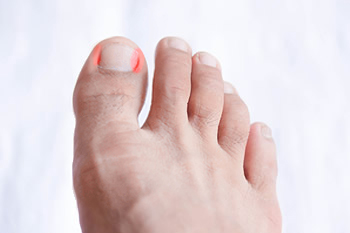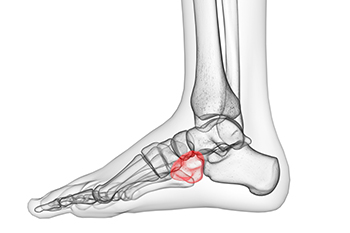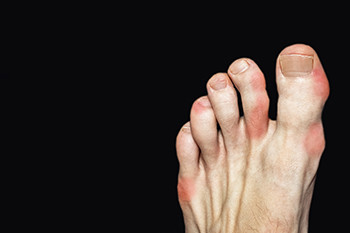
Connellsville


An ingrown toenail occurs when the nail grows into the skin surrounding it. Oftentimes this happens from cutting toenails too short and tapering nail edges. Ingrown toenails can also occur from wearing shoes or socks that are too tight or short or from a trauma, such as stubbing the toe. It can look bad and feel painful. It can also turn into an infection. The correct way of trimming toenails is to cut them straight across with no curvature. If you have cut the nails properly, you should be able to get a fingernail under the sides and end of the nail. If you have an ingrown toenail, you can try soaking the toe in warm water with Epsom salts, which may help soften the skin surrounding the toenail and reduce inflammation and pain. Consider wearing sandals or shoes with a lot of room in the toe box until the nail has healed. If the toenail looks infected or if it is not healing well, see a podiatrist who can suggest further treatments.
Ingrown toenails may initially present themselves as a minor discomfort, but they may progress into an infection in the skin without proper treatment. For more information about ingrown toenails, contact Dr. Arnold Tarpley, Jr. of Tarpley Foot and Ankle Center. Dr. Tarpley can provide the care you need to keep you pain-free and on your feet.
Ingrown Toenails
Ingrown toenails are caused when the corner or side of a toenail grows into the soft flesh surrounding it. They often result in redness, swelling, pain, and in some cases, infection. This condition typically affects the big toe and may recur if it is not treated properly.
Causes
You are more likely to develop an ingrown toenail if you are obese, have diabetes, arthritis, or have any fungal infection in your nails. Additionally, people who have foot or toe deformities are at a higher risk of developing an ingrown toenail.
Symptoms
Some symptoms of ingrown toenails are redness, swelling, and pain. In rare cases, there may be a yellowish drainage coming from the nail.
Treatment
Ignoring an ingrown toenail can have serious complications. Infections of the nail border can progress to a deeper soft-tissue infection, which can then turn into a bone infection. You should always speak with your podiatrist if you suspect you have an ingrown toenail, especially if you have diabetes or poor circulation.
If you have any questions, please feel free to contact one of our offices located in Uniontown, and Connellsville, PA . We offer the newest diagnostic and treatment technologies for all your foot care needs.

The cuboid bone is found below the ankle on the inside of the foot and can become forced out of alignment during an injury. This is known as cuboid syndrome. Common symptoms can include swelling, pain, and inflammation in the ankle, and it can be difficult to walk. The pain from this condition is felt on the outside of the foot, and it may cause the toes to turn toward each other. The discomfort may gradually become worse when activities are pursued, and it can hurt to stand on tiptoes. Cuboid syndrome is diagnosed by having an X-ray taken, in addition to performing a physical examination. Research has indicated that it is beneficial to wear shoes that have adequate support, and enough room for the toes to move freely in. If you have pain in this part of your ankle and foot, it is strongly urged that you contact a podiatrist as quickly as possible so the correct treatment can begin.
Cuboid syndrome, also known as cuboid subluxation, occurs when the joints and ligaments near the cuboid bone in the foot become torn. If you have cuboid syndrome, consult with Dr. Arnold Tarpley, Jr. from Tarpley Foot and Ankle Center. Dr. Tarpley will assess your condition and provide you with quality foot and ankle treatment.
Cuboid syndrome is a common cause of lateral foot pain, which is pain on the outside of the foot. The condition may happen suddenly due to an ankle sprain, or it may develop slowly overtime from repetitive tension through the bone and surrounding structures.
Causes
The most common causes of cuboid syndrome include:
Symptoms
A common symptom of cuboid syndrome is pain along the outside of the foot which can be felt in the ankle and toes. This pain may create walking difficulties and may cause those with the condition to walk with a limp.
Diagnosis
Diagnosis of cuboid syndrome is often difficult, and it is often misdiagnosed. X-rays, MRIs and CT scans often fail to properly show the cuboid subluxation. Although there isn’t a specific test used to diagnose cuboid syndrome, your podiatrist will usually check if pain is felt while pressing firmly on the cuboid bone of your foot.
Treatment
Just as the range of causes varies widely, so do treatments. Some more common treatments are ice therapy, rest, exercise, taping, and orthotics.
If you have any questions, please feel free to contact one of our offices located in Uniontown, and Connellsville, PA . We offer the newest diagnostic and treatment technologies for all your foot care needs.

Working out and exercising are essential parts of what it means to be a healthy, active person. Not only does exercise help us burn extra calories, it helps us have stronger bodies. However, if one is not careful, exercise may lead to a litany of different foot conditions. An individual who is exercising might experience sore ankles after engaging in physical activity. If this applies to you, you might consider performing ankle and joint mobility exercises that are comfortable in order to stretch the area. This might reduce pain from sore ankles. Additionally, one may be able to prevent ankle pain from occurring in the first place if one properly warms up before a workout. Contact a podiatrist today for more information on ankle pain.
Ankle pain can be caused by a number of problems and may be potentially serious. If you have ankle pain, consult with Dr. Arnold Tarpley, Jr. from Tarpley Foot and Ankle Center. Dr. Tarpley will assess your condition and provide you with quality foot and ankle treatment.
Ankle pain is any condition that causes pain in the ankle. Due to the fact that the ankle consists of tendons, muscles, bones, and ligaments, ankle pain can come from a number of different conditions.
Causes
The most common causes of ankle pain include:
Symptoms
Symptoms of ankle injury vary based upon the condition. Pain may include general pain and discomfort, swelling, aching, redness, bruising, burning or stabbing sensations, and/or loss of sensation.
Diagnosis
Due to the wide variety of potential causes of ankle pain, podiatrists will utilize a number of different methods to properly diagnose ankle pain. This can include asking for personal and family medical histories and of any recent injuries. Further diagnosis may include sensation tests, a physical examination, and potentially x-rays or other imaging tests.
Treatment
Just as the range of causes varies widely, so do treatments. Some more common treatments are rest, ice packs, keeping pressure off the foot, orthotics and braces, medication for inflammation and pain, and surgery.
If you have any questions, please feel free to contact one of our offices located in Uniontown, and Connellsville, PA . We offer the newest diagnostic and treatment technologies for all your foot care needs.

People who experience gout often have severe pain and discomfort. It is a form of arthritis that affects the joints in the big toe. The pain comes from inflammation that occurs in these joints and is often debilitating. Gout attacks may occur due to genetics or consuming specific foods. These foods include red meat, organ meat, shellfish, and alcoholic beverages. Existing medical conditions like high blood pressure, diabetes, or kidney disorders may also contribute to the onset of gout. There are effective prevention techniques that may help to reduce gout episodes. Incorporating a gentle exercise routine and changing eating habits that can accommodate healthy foods are generally successful in reducing further attacks. If you have had one or several bouts of gout, it is strongly advised that you are under the care of a podiatrist who can help you manage this painful condition.
Gout is a painful condition that can be treated. If you are seeking treatment, contact Dr. Arnold Tarpley, Jr. from Tarpley Foot and Ankle Center. Dr. Tarpley will treat your foot and ankle needs.
What Is Gout?
Gout is a form of arthritis that is characterized by sudden, severe attacks of pain, redness, and tenderness in the joints. The condition usually affects the joint at the base of the big toe. A gout attack can occur at any random time, such as the middle of the night while you are asleep.
Symptoms
Risk Factors
Prior to visiting your podiatrist to receive treatment for gout, there are a few things you should do beforehand. If you have gout you should write down your symptoms--including when they started and how often you experience them, important medical information you may have, and any questions you may have. Writing down these three things will help your podiatrist in assessing your specific situation so that he or she may provide the best route of treatment for you.
If you have any questions, please feel free to contact one of our offices located in Uniontown, and Connellsville, PA . We offer the newest diagnostic and treatment technologies for all your foot care needs.

Nerve tissue between the third and fourth toes that becomes thick, or compressed, may indicate a condition known as Morton’s neuroma. It happens when there is not enough room for the toes to move freely in from wearing certain types of shoes. High heels fall into this category, and may cause the nerve to become irritated and inflamed. It is considered to be a painful foot condition, and relief may be found when different shoes are worn. This may be a successful treatment method if it is noticed early, and completing daily activities with ease may resume. In severe cases, where walking becomes difficult, surgery may be a necessary option for permanent relief by removing the affected nerve. The symptoms that many people can experience with this condition include the sensation of standing on a pebble or marble, and pain may radiate from the ball of the foot. Morton’s neuroma is a serious foot condition, and if you have any of the above symptoms, it is strongly advised that you are under the care of a podiatrist who can help you to find permanent relief.
Morton’s neuroma is a very uncomfortable condition to live with. If you think you have Morton’s neuroma, contact Dr. Arnold Tarpley, Jr. of Tarpley Foot and Ankle Center. Dr. Tarpley will attend to all of your foot care needs and answer any of your related questions.
Morton’s Neuroma
Morton's neuroma is a painful foot condition that commonly affects the areas between the second and third or third and fourth toe, although other areas of the foot are also susceptible. Morton’s neuroma is caused by an inflamed nerve in the foot that is being squeezed and aggravated by surrounding bones.
What Increases the Chances of Having Morton’s Neuroma?
Morton’s neuroma is a very treatable condition. Orthotics and shoe inserts can often be used to alleviate the pain on the forefront of the feet. In more severe cases, corticosteroids can also be prescribed. In order to figure out the best treatment for your neuroma, it’s recommended to seek the care of a podiatrist who can diagnose your condition and provide different treatment options.
If you have any questions, please feel free to contact one of our offices located in Uniontown, and Connellsville, PA . We offer the newest diagnostic and treatment technologies for all your foot care needs.